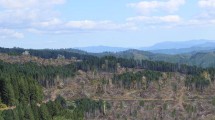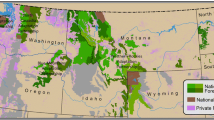Abstract
Conserving biological diversity in a changing climate poses major challenges for land managers and society. Effective adaptive strategies for dealing with climate change require a socio-ecological systems perspective. We highlight some of the projected ecological responses to climate change in the Pacific Northwest, U.S.A and identify possible adaptive actions that federal forest managers could take. The forest landscape, ownership patterns and recent shift toward ecologically based forest management provide a good starting place for conserving biological diversity under climate change. Nevertheless, undesirable changes in species and ecosystems will occur and a number of adaptive actions could be undertaken to lessen the effects of climate change on forest ecosystems. These include: manipulation of stand and landscape structure to increase ecological resistance and resilience; movement of species and genotypes; and engaging in regional, multi-ownership planning to make adaptive actions more effective. Although the language and goals of environmental laws and policies were developed under the assumption of stable climate and disturbance regimes, they appear to be flexible enough to accommodate many adaptive actions. It is less certain, however, if sufficient social license and economic capacity exist to undertake these actions. Given the history of contentious and litigious debate about federal forest management in this region, it is likely that some of these actions will be seen as double-edge swords, spurring social resistance, especially where actions involve cutting trees. Given uncertainties and complexity, collaborative efforts that promote learning (e.g. adaptive management groups) must be rejuvenated and expanded.



Similar content being viewed by others
References
Sheperd et al (2009) Geoengineering the climate system: science, governance and uncertainty. The Royal Society Policy document 10/09. http://royalsociety.org/displaypagedoc.asp?id=35151. Accessed 9 Oct 2009
Agee JK (1993) Fire ecology of Pacific Northwest forests. Island Press, Washington, DC
Aitken SN, Yeaman S, Holliday JA, Wang T, Curtis-McLane S (2008) Adaptation, migration or extirpation: climate change outcomes for tree populations. Evol Appl 1:95–111
Bangs EE, Fritts SH, Fontaine JA, Smith DW, Murphy KM, Mack CM, Niemeyer CC (1998) Status of gray wolf restoration in Montana, Idaho, and Wyoming. Wildl Soc Bull 26:785–798
Baron JS, Gunderson L, Allen CD, Fleishman E, Mckenzie D, Meyerson LA, Oropeza J, Stephenson N (2009) Options for national parks and reserves for adapting to climate change. Environ Manag 44:1033–1042
Campbell RK (1986) Genecology of Douglas-fir in a watershed in the Oregon Cascades. Ecology 60:1036–1050
Carroll C, Dunk JR, Moilanen A (2009) Optimizing resiliency of reserve networks to climate change: multispecies conservation planning in the Pacific Northwest, USA. Glob Chang Biol doi:10.1111/j.1365-2486.2009.01965.x
Chape S, Harrison J, Spalding M, Lysenko I (2005) Measuring the extent and effectiveness of protected areas as an indicator for meeting global biodiversity targets. Philos Trans R Soc 360:443–455
Cissel JH, Swanson FJ, Weisberg PJ (1999) Landscape management using historical fire regimes: Blue River, Oregon. Ecol Appl 9:1217–1231
Craig RK (2010) “Stationarity is dead”—long live transformation: five principles for climate change adaptation law. Harvard Environ Law Rev 34:9–73
Daly C, Conklin DR, Unsworth MH (2009) Local atmospheric decoupling in complex topography alters climate change impacts. Int J Climatol. doi:10.1002/joc.2007
Finney MA, Seli RC, McHugh CW, Ager AA, Bahro B, Agee JK (2007) Simulation of long-term landscape-level fuel treatment effects on large wildfires. Int J Wildl Fire 16:712–727
Franklin JF, Dyrness CT (1988) Natural vegetation of Oregon and Washington. Oregon State University Press, Corvallis
Franklin JF, Swanson FJ, Harmon ME, Perry DA, Spies TA, Dale VH, McKee A, Ferrell WK, Gregory SV, Lattin JD, Schowalter TD, Larsen D, Means JE (1992) Effects of climate change on forests in Northwestern North America in climate change and biological diversity. In: Peters RL, Lovejoy TE (eds) Global warming and biological diversity. Yale University Press, New Haven, pp 244–257
Giglia SK (2004) Spatial and temporal patterns of “super-old” Doulgas-fir trees in the central western Cascades, Oregon. M.S. Thesis. Oregon State University
Hallegatte S (2009) Strategies to adapt to an uncertain climate change. Glob Environ Chang. doi:10.1016/j.gloenvcha.2008.12.003
Hays SP (1989) Beauty, health, and permanence: environmental politics in the US 1955–1985. Cambridge University Press, Cambridge
Healey SP, Cohen WB, Spies TA, Moeur M, Pflugmacher D, Whitley MG, Lefsky M (2008) The relative impact of harvest and fire upon landscape-level dynamics of older forests: lessons from the Northwest Forest Plan. Ecosystems 11:1106–1119
Jackson ST, Hobbs RJ (2009) Ecological restoration in light of ecological history. Science 325:567–569
Johnson KN, Swanson FJ (2009) Historical context of old-growth forests in the Pacific Northwest—policy, practices, and competing world views. In: Spies TA, Duncan SL (eds) Old growth in a new world: a Pacific Northwest icon reexamined. Island Press, Washington, DC, pp 12–28
Johnson KN, Swanson FJ, Herring M, Greene S (eds) (1999) Bioregional assessments: science at the crossroads of management and policy. Island Press, Washington, DC
Johnson KN, Franklin JF (2009) Restoration of Federal Forests in the Pacific Northwest: strategies and management implications http://www.cof.orst.edu/cof/fs/PDFs/JohnsonRestoration_Aug15_2009.pdf
Keele DM, Malmsheimer RW, Floyd DW, Perez JE (2006) Forest Service land management litigation 1989–2002. J For 104:196–202
Keiter RB (2003) Keeping faith with nature: ecosystems, democracy, and America’s public lands. Yale University Press, New Haven
Kurz WA, Dymond CC, Stinson G, Rampley GJ, Neilson ET, Carroll AL, Ebata T, Safranyik L (2008) Mountain pine beetle and forest carbon feedback to climate change. Nature 452:987–990
Lint J (Technical Coord.) (2005) Status and trends of northern spotted owl populations and habitat. USDA Forest Service, PNW Research Station. General Technical Report, PNW-GTR-648
Littell JS, Peterson DL, Tjoelker M (2008) Douglas-fir growth-climate relationships along biophysical gradients in mountain protected areas of the northwestern U.S. Ecol Monogr 78:349–368
Littell JS, Oneil EE, McKenzie D, Hicke JA, Lutz JA, Norheim RA, McGuire Elsner M (2009) Forest ecosystems, disturbance, and climatic change in Washington State, USA. Chapter 7 In: The Washington climate change impacts assessment: evaluating washington’s future in a changing climate. Climate Impacts Group, University of Washington, Seattle, Washington
Marris E (2009) Planting the forest of the future. Nature 459:906–908
McKenzie D, Gedlof Z, Peterson DL, Mote P (2004) Climatic change, wildfire and conservation. Conserv Biol 18:890–902
Millar CI, Stephenson NL, Stephens SL (2007) Climate change and forests of the future: managing in the face of uncertainty. Ecol Appl 17:2145–2151
Moeur M, Spies TA, Hemstrom M, Martin JR, Alegria J, Browning J, Cissel J, Cohen WB, Demeo TE, Healey S, Warbington R (2005) Northwest Forest Plan—the first 10 years (1994–2003): status and trend of late-successional and old-growth forest. USDA Forest Service General Technical Report PNW-GTR-646. Portland, OR, USA
Mote PW (2003) Trends in snow water equivalent in the Pacific Northwest and their climatic causes. Geophys Res Lett 30. doi:10.1029/2003GL017258
North M, Stine P, O’Hara K, Zielinski W, and Stephens S. 2009. An ecosystem management strategy for Sierran mixed-conifer forests. Gen. Tech. Rep. PSW-GTR-220. USDA Forest Service, Pacific Southwest Research Station, 49 pp
Noss RF, Franklin JF, Baker WL, Schoennagel T, Moyle PB (2006) Managing fire-prone forests in the western United States. Frontiers 4:481–487
Ohmann JL, Spies TA (1998) Regional gradient analysis and spatial pattern of woody plant communities of Oregon forests. Ecol Monogr 68:151–182
Olsen DH, Burnett KM (2009) Design and management of linkage areas across headwater drainages to conserve biodiversity in forest ecosystems. For Ecol Manag 258S:S117–S126
Orr DW (2009) Baggage: the case for climate mitigation. Conserv Biol 23:790–793
Phillips NG, Ryan MG, Bond BJ, MCDowell NG, Hinckley TM, Earmak J (2003) Reliance on stored water increases with tree size in three species in the Pacific Northwest. Tree Physiol 23:237–245
Randin CF, Engler R, Normand S, Zappa M, Zimmerman N, Pearman P, Vittoz P, Thuiller W, Guisan A (2009) Climate change and plant distribution: local models predict high-elevation persistence. Glob Chang Biol 15:1557–1569
Rehfeldt GE, Crookston NL, Warwell MV, Evans JS (2006) Empirical analysis of plant-climate relationships for the western United States. Int J Plant Sci 167:1123–1150
Reiman BE, Isaak D, Adams S, Horan D, Nagel D, Luce C, Myers D (2007) Anticipated climate warming effects on bull trout habitats and populations across the interior Columbia River Basin. Trans Am Fish Soc 136:1552–1565
Salathé EP Jr, Steed R, Mass CF, Zahn PH (2008) A high-resolution climate model for the U.S. Pacific Northwest: mesoscale feedbacks and local responses to climate change. J Clim 21:5708–5726
Schwandt JW (2006) Whitebark pine in peril: a case for restoration. USDA Forest Service, Forest Health Protection. R1-06-28
Shindler B, Mallon AL (2009) Public acceptance of disturbance-based forest management: a study of the Blue River Landscape Strategy in the Central Cascades Adaptive Management Area. USDA Forest Service Research Paper PNW-RP-581. Portland, OR USA
Spies TA, McComb MC, Kennedy RSH, McGrath MT, Olsen K, Pabst RJ (2007) Potential effects of forest policies on terrestrial biodiversity in a multi-ownership province. Ecol Appl 17:48–65
St. Clair BJ, Howe GT (2007) Genetic maladaptation of coastal Douglas-fir seedlings to future climates. Glob Chang Biol 13:1441–1454
Stankey GH (2009) Is adaptive management too risky for old growth forests? In: Spies TA, Duncan SL (eds) Old growth in a new world: a Pacific Northwest icon reexamined. Island Press, Washington, DC, pp 201–210
Stephens SL, Ruth LW (2005) Federal Forest-fire policy in the United States. Ecol Appl 15:532–542
Thomas SC, Halpern CB, Falk DA, Liquori DA, Austin KA (1999) Plant diversity in managed forests: understory responses to thinning and fertilization. Ecol Appl 9:864–879
USDA (2010) National Forest Management Act (NFMA)/Planning. http://www.fs.fed.us/emc/nfma/index.htm
van Mantgem PJ, Stephenson NL, Byrne JC, Daniels LD, Franklin JF, Fulé PZ, Harmon ME, Larson AJ (2009) Widespread increase of tree mortality rates in the Western United States. Science 323:521–524
Westerling AL, Hidalgo HG, Cayan DR, Swetnam TW (2006) Warming and earlier spring increases western U.S. forest wildfire activity. Science 313:940–943
Wiens JA, Stralberg D, Jongsomjit D, Howell CA, Snyder MA (2009) Niches, models, and climate change: assessing the assumptions and uncertainties. Proc Natl Acad Sci USA 106:19729–19736
Zhang X, Zwiers FW, Hegerl GC, Lambert FH, Gillett NP, Solomon S, Stott PA, Nozawa T (2007) Detection of human influence on twentieth-century precipitation trends. Nature 448:461–465
Acknowledgements
Keith Olsen assisted with graphics, Brad St. Clair and Glenn Howe provided helpful discussions, and Becky Kerns made valuable comments on an earlier version of the manuscript.
Author information
Authors and Affiliations
Corresponding author
Rights and permissions
About this article
Cite this article
Spies, T.A., Giesen, T.W., Swanson, F.J. et al. Climate change adaptation strategies for federal forests of the Pacific Northwest, USA: ecological, policy, and socio-economic perspectives. Landscape Ecol 25, 1185–1199 (2010). https://doi.org/10.1007/s10980-010-9483-0
Received:
Accepted:
Published:
Issue Date:
DOI: https://doi.org/10.1007/s10980-010-9483-0




